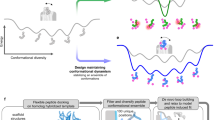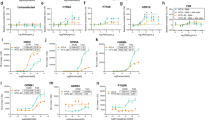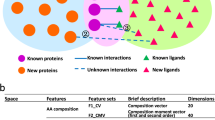Abstract
Prediction of cellular response to multiple stimuli is central to evaluating patient-specific clinical status and to basic understanding of cell biology. Cross-talk between signaling pathways cannot be predicted by studying them in isolation and the combinatorial complexity of multiple agonists acting together prohibits an exhaustive exploration of the complete experimental space. Here we describe pairwise agonist scanning (PAS), a strategy that trains a neural network model based on measurements of cellular responses to individual and all pairwise combinations of input signals. We apply PAS to predict calcium signaling responses of human platelets in EDTA-treated plasma to six different agonists (ADP, convulxin, U46619, SFLLRN, AYPGKF and PGE2) at three concentrations (0.1, 1 and 10 × EC50). The model predicted responses to sequentially added agonists, to ternary combinations of agonists and to 45 different combinations of four to six agonists (R = 0.88). Furthermore, we use PAS to distinguish between the phenotypic responses of platelets from ten donors. Training neural networks with pairs of stimuli across the dose-response regime represents an efficient approach for predicting complex signal integration in a patient-specific disease milieu.
This is a preview of subscription content, access via your institution
Access options
Subscribe to this journal
Receive 12 print issues and online access
$209.00 per year
only $17.42 per issue
Buy this article
- Purchase on Springer Link
- Instant access to full article PDF
Prices may be subject to local taxes which are calculated during checkout




Similar content being viewed by others
References
Lloyd-Jones, D. et al. Heart disease and stroke statistics–2009 update: a report from the American Heart Association Statistics Committee and Stroke Statistics Subcommittee. Circulation 119, e21–e181 (2009).
Furie, B. & Furie, B.C. In vivo thrombus formation. J. Thromb. Haemost. 5, 12–17 (2007).
Bray, D. Protein molecules as computational elements in living cells. Nature 376, 307–312 (1995).
Bray, D. Molecular networks: the top-down view. Science 301, 1864–1865 (2003).
Purvis, J.E., Chatterjee, M.S., Brass, L.F. & Diamond, S.L. A molecular signaling model of platelet phosphoinositide and calcium regulation during homeostasis and P2Y1 activation. Blood 112, 4069–4079 (2008).
Siess, W. Molecular mechanisms of platelet activation. Physiol. Rev. 69, 58–178 (1989).
Bohne, A., Fukami, M.H. & Holmsen, H. EDTA inhibits collagen-induced ATP plus ADP secretion and tyrosine phosphorylation in platelets independently of Mg2+ chelation and decrease in pH. Platelets 13, 437–442 (2002).
Lages, B. & Harvey, J.W. Heterogeneous defects of platelet secretion and responses to weak agonists in patients with bleeding disorders. Br. J. Haematol. 68, 53–62 (1988).
Cho, M.J. et al. The roles of alpha IIbbeta 3-mediated outside-in signal transduction, thromboxane A2, and adenosine diphosphate in collagen-induced platelet aggregation. Blood 101, 2646–2651 (2003).
Brass, L.F., Shattil, S.J., Kunicki, T.J. & Bennett, J.S. Effect of calcium on the stability of the platelet membrane glycoprotein IIb-IIIa complex. J. Biol. Chem. 260, 7875–7881 (1985).
Polgar, J. et al. Platelet activation and signal transduction by convulxin, a C-type lectin from Crotalus durissus terrificus (tropical rattlesnake) venom via the p62/GPVI collagen receptor. J. Biol. Chem. 272, 13576–13583 (1997).
Mukherjee, D., Nissen, S.E. & Topol, E.J. Risk of cardiovascular events associated with selective COX-2 inhibitors. JAMA 286, 954–959 (2001).
Yee, D.L., Sun, C.W., Bergeron, A.L., Dong, J.-f. & Bray, P.F. Aggregometry detects platelet hyperreactivity in healthy individuals. Blood 106, 2723–2729 (2005).
Panzer, S., Höcker, L. & Koren, D. Agonists-induced platelet activation varies considerably in healthy male individuals: studies by flow cytometry. Ann. Hematol. 85, 121–125 (2006).
Packham, M.A., Guccione, M.A., Chang, P.L. & Mustard, J.F. Platelet-aggregation and release-effects of low concentrations of thrombin or collagen. Am. J. Physiol. 225, 38–47 (1973).
Grant, J.A. & Scrutton, M.C. Positive interaction between agonists in the aggregation response of human-blood platelets-interaction between adp, adrenaline and vasopressin. Br. J. Haematol. 44, 109–125 (1980).
Hallam, T.J., Scrutton, M.C. & Wallis, R.B. Synergistic responses and receptor occupancy in rabbit-blood platelets. Thromb. Res. 27, 435–445 (1982).
Jones, C.I. et al. A functional genomics approach reveals novel quantitative trait loci associated with platelet signaling pathways. Blood 114, 1405–1416 (2009).
Hsueh, R.C. et al. Deciphering signaling outcomes from a system of complex networks. Sci. Signal. 2, ra22 (2009).
Nieswandt, B. & Watson, S.P. Platelet-collagen interaction: is GPVI the central receptor? Blood 102, 449–461 (2003).
Knight, C.G. et al. Collagen-platelet interaction: Gly-Pro-Hyp is uniquely specific for platelet Gp VI and mediates platelet activation by collagen. Cardiovasc. Res. 41, 450–457 (1999).
Hers, I. et al. Evidence against a direct role of the integrin alpha2beta1 in collagen-induced tyrosine phosphorylation in human platelets. Eur. J. Biochem. 267, 2088–2097 (2000).
Foster, C.J. et al. Molecular identification and characterization of the platelet ADP receptor targeted by thienopyridine antithrombotic drugs. J. Clin. Invest. 107, 1591–1598 (2001).
Covic, L., Gresser, A.L. & Kuliopulos, A. Biphasic kinetics of activation and signaling for PAR1 and PAR4 thrombin receptors in platelets. Biochemistry 39, 5458–5467 (2000).
Shapiro, M.J., Weiss, E.J., Faruqi, T.R. & Coughlin, S.R. Protease-activated receptors 1 and 4 are shutoff with distinct kinetics after activation by thrombin. J. Biol. Chem. 275, 25216–25221 (2000).
Cho, M.J. & Allen, M.A. Chemical stability of prostacyclin (PGI2) in aqueous-solutions. Prostaglandins 15, 943–954 (1978).
Coleman, R.A., Humphrey, P.P.A., Kennedy, I., Levy, G.P. & Lumley, P. Comparison of the actions of U-46619, a prostaglandin H2-analogue, with those of prostaglandin-H2 and thromboxane-A2 on some isolated smooth-muscle preparations. Br. J. Pharmacol. 73, 773–778 (1981).
Roach, T.I.A. et al. Signaling and crosstalk by C5a and UDP in macrophages selectively use PLCbeta 3 to regulate intracellular free calcium. J. Biol. Chem. 283, 17351–17361 (2008).
Jain, L.C. & Medsker, L.R. Recurrent Neural Networks: Design and Applications (CRC Press, 1999).
Eugen, D. The use of NARX neural networks to predict chaotic time series. WSEAS Trans. Comp. Res. 3, 182–191 (2008).
Busch, H. et al. Gene network dynamics controlling keratinocyte migration. Mol. Syst. Biol. 4, 199 (2008).
Janes, K.A. et al. Systems model of signaling identifies a molecular basis set for cytokine-induced apoptosis. Science 310, 1646–1653 (2005).
Kemp, M.L., Wille, L., Lewis, C.L., Nicholson, L.B. & Lauffenburger, D.A. Quantitative network signal combinations downstream of TCR activation can predict IL-2 production response. J. Immunol. 178, 4984–4992 (2007).
Acknowledgements
The authors thank H. Li for suggesting the permutation test to evaluate the significance of donor clustering. This work was supported by the US National Institutes of Health R01-HL-56621 (S.L.D.), R33-HL-87317 (S.L.D. and L.F.B.) and T32-HG000046 (J.E.P.).
Author information
Authors and Affiliations
Contributions
M.S.C. designed and performed all experiments. J.E.P. constructed neural network models of platelet activation. M.S.C. wrote the paper with contributions from all authors. L.F.B. advised on experimental conditions, and S.L.D. conceived the study.
Corresponding author
Ethics declarations
Competing interests
The authors declare no competing financial interests.
Supplementary information
Supplementary Text and Figures
Supplementary Tables 1–3, Supplementary Figs. 1–15 and Supplementary Discussion (PDF 3839 kb)
Rights and permissions
About this article
Cite this article
Chatterjee, M., Purvis, J., Brass, L. et al. Pairwise agonist scanning predicts cellular signaling responses to combinatorial stimuli. Nat Biotechnol 28, 727–732 (2010). https://doi.org/10.1038/nbt.1642
Received:
Accepted:
Published:
Issue Date:
DOI: https://doi.org/10.1038/nbt.1642
This article is cited by
-
Cytokine-mediated communication: a quantitative appraisal of immune complexity
Nature Reviews Immunology (2019)
-
Understanding non-linear effects from Hill-type dynamics with application to decoding of p53 signaling
Scientific Reports (2018)
-
Combining data-driven neural networks of platelet signalling with large-scale ODE models of coagulation
Sādhanā (2018)
-
The Relative Role of Soluble Guanylyl Cylase Dependent and Independent Pathways in Nitric Oxide Inhibition of Platelet Aggregation Under Flow
Cellular and Molecular Bioengineering (2014)
-
Multiscale Systems Biology and Physics of Thrombosis Under Flow
Annals of Biomedical Engineering (2012)



